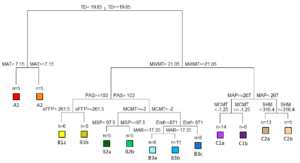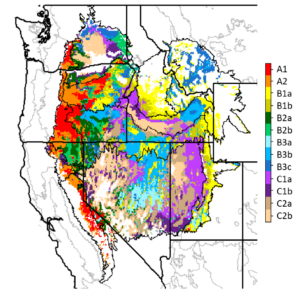Authors
Jeff Ott, Francis Kilkenny, USFS RMRS
Bradley St. Clair, USFS PNWRS
Beth Leger, UNR
Richard C. Johnson, ARS
Matthew E. Horning, USFS Service, R6
Overview
In this study, we characterize adaptive genetic variation in bottlebrush squirreltail (Elymus elymoides), a short-lived, self-pollinating, perennial bunchgrass of restoration importance, found in semi-arid regions of western North America, across a core section of its range in the northern Great Basin and Intermountain West region.
Findings –
- Squirreltail trait × environment relationships follow similar patterns to other Great Basin and Intermountain West bunchgrasses, indicating similar spatial patterns of natural selection across these taxa.
- Squireltail has highly plastic trait expression, which might allow for seed sources to establish and persist in areas where they are somewhat maladapted.
- Subspecies groupings were an important variable in developing seed transfer zones, although similarities between zonation suggest that the ‘climate-only’ model may be sufficient for management seeding decisions.
- Multivariate regression trees successfully provided a logical hierarchical structure that will allow managers to combine seed transfer zones for practical purposes.

Figure 1. Multivariate regression tree model identifying seed transfer zones based on relationships between climate variables of source locations and traits of 98 Elymus elymoides populations measured at three common garden sites. Each partition separates populations differing by principal component (PC) axes of trait values by site at the indicated threshold value of the most strongly correlated predictor variable. Bars show relative values of PC axes 1-18 from left to right, and n indicates the number of populations represented in each terminal leaf. Colors and code names at terminal leaves correspond to seed transfer zones mapped in Figure 2

Figure 2. Seed transfer zone map for Elymus elymoides based on multivariate regression tree modeling of trait × climate relationships. Zone colors and code names correspond to terminal leaves of model shown in Figure 1. Mapped area is defined by EPA Level III Ecoregions, omitting areas beyond 1 standard deviation of sampled range of climate variables in the study.
Purpose
In this study, we characterize adaptive genetic variation in bottlebrush squirreltail (Elymus elymoides), across a core section of its range in the northern Great Basin and Intermountain West region.
Geography
Seed was collected over three years from 110 wildland populations in the Intermountain West. Plants were transplanted to common gardens in Central Ferry, WA, Powell Butte, OR, and Reno, NV.